Madrid, the buzzing capital of Spain, is one of my favorite cities. I have been coming here since the 1980’s when my Mom and I decided to spend a summer traipsing through Europe together. Ah, such great memories….
When visiting Madrid, it’s tempting to stay inside the capital’s lively plazas and art museums. But some of the true magic lies just beyond the city limits. From medieval walled cities in Spain to royal gardens and hidden villages, the towns near Madrid Spain offer unforgettable day trips — and most are just 30 minutes to one hour away by train.
In this guide we explore some significant towns near Madrid Spain. We will share their attractions and some practical travel information so that you can decide which ones you want to visit and how. Plus, you’ll get real traveler and locals tips to make your greater Madrid Spain itinerary smooth and memorable.
Toledo: One of the Top Historic Walled Cities in Spain
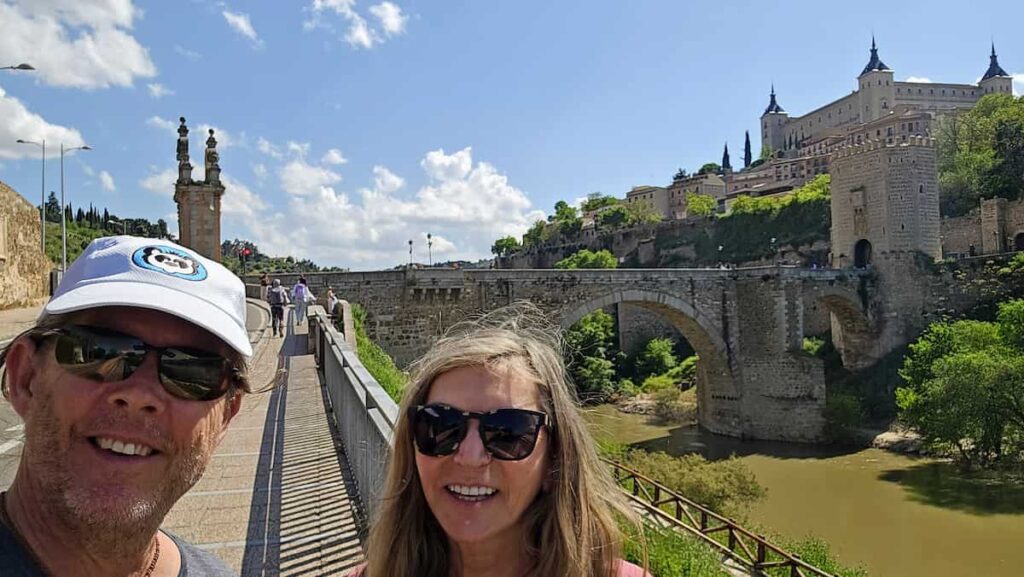
Located a short distance southwest of Madrid, Toledo, a UNESCO World Heritage site, is profoundly connected to the past. Perched on a hill overlooking the Tagus River, the city features a striking landscape of intricate medieval streets, ancient synagogues, sacred cathedrals, and imposing fortresses.
Walking around Toledo, you can see how different cultures interacted together and coexisted. Christian, Muslim, and Jewish communities lived in harmony here (prior to 1492), leaving an enduring influence on its architecture and artistic expressions. Once the capital of Spain, the city was also the residence of El Greco, the famous painter.
Keep in mind that since this medieval town is set on a hill, you will be walking either up or down a hill for most of your visit – so we suggest comfortable shoes for your journey. A day here is a perfect amount of time to see all there is to see in one of our favorite walled cities in Spain.
Notable attractions
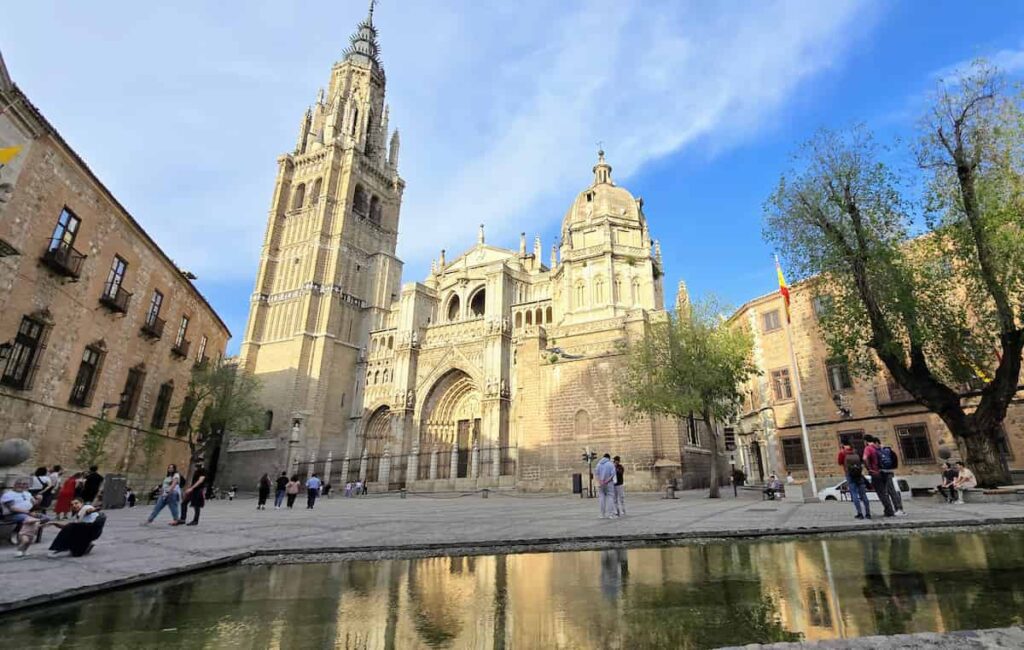
Toledo Cathedral: Built in 1227, the Toledo Cathedral is a significant example of Gothic architecture, featuring elaborate stained glass and paintings by El Greco.
Alcázar of Toledo: The Alcázar of Toledo started as a Roman palace in the 3rd century. It became a fortress in the 10th century under the Umayyad Caliphate, but the building we see today was constructed in the 16th century by Charles V and now houses a military museum. The panoramic city views are fantastic,especially great during the Golden Hour.
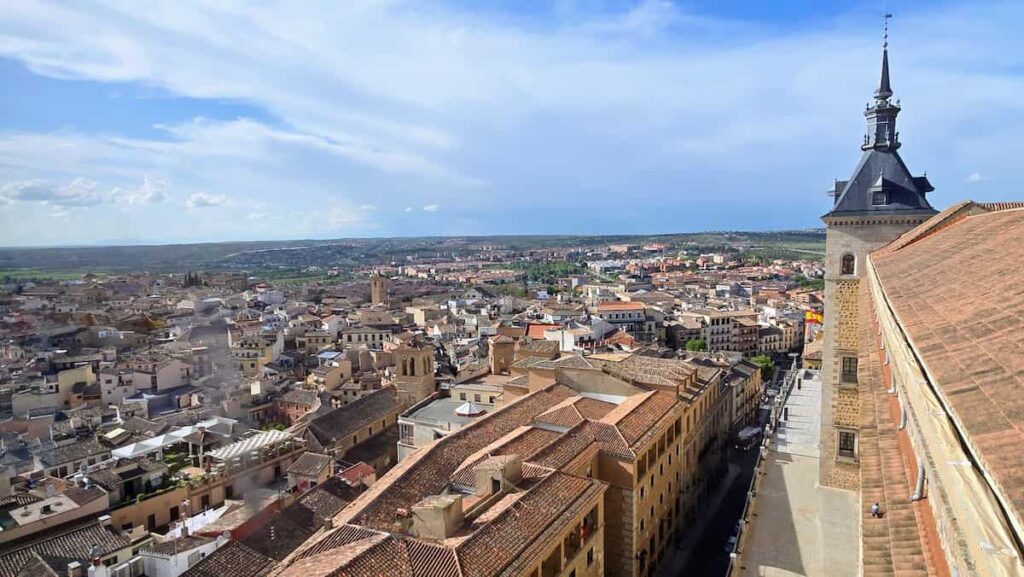
Now, if you happen to arrive in Toledo after the Alcazar has shut for the day, you can still visit the Toledo Biblioteca (library) which is free to enter and is open much later than the Alcazar.
You can go up to the library and see gorgeous panoramic views of the city from the library floor or the cafetaria above. In addition, the library itself is worth a visit (although you are not permitted to take pictures in it). There is also an open terrace overlooking the courtyard of the library below.
Synagogue of Santa María la Blanca: Considered one of the oldest synagogues in Europe, dating back to the 12th century, it showcases a unique Mudéjar architectural style. It was later converted into a church. Located within Toledo’s Jewish quarter.
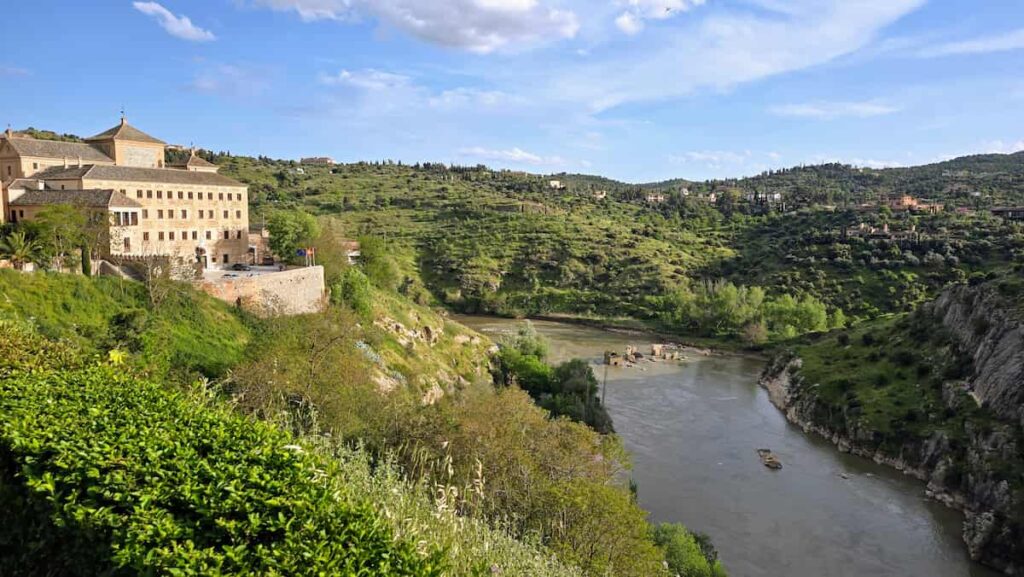
Juderia -Jewish Quarter: Away from the principal thoroughfare of Calle del Comercio, explore the Judería (Jewish Quarter), particularly streets such as Calle de Samuel Leví or Calle del Ángel. To me, this is the most beautiful part of Toledo – peaceful with gorgeous lookout points over the Targus river – especially during sunset.
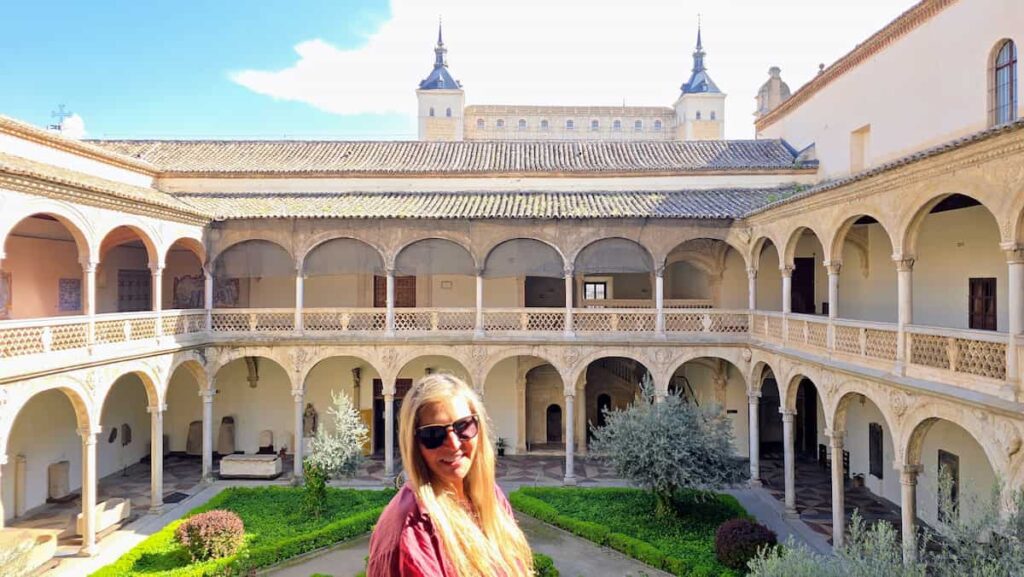
Monastery of San Juan de los Reyes: This monastery was built between 1477 and 1504 in Isabelline Gothic style (transitioning between Gothic and early Renaissance), which we see in it’s detailed carvings. There are great views of the Tagus River below from the viewing platform of the monastery.
The Ancient Walls: As one of the top walled cities in Spain, Toledo’s ramparts provide elevated walkways with great city views. Check out the Puerta de Bisagra (Bisagra Gate) originally constructed by the Moors in the 10th century and then renovated in the 16th.
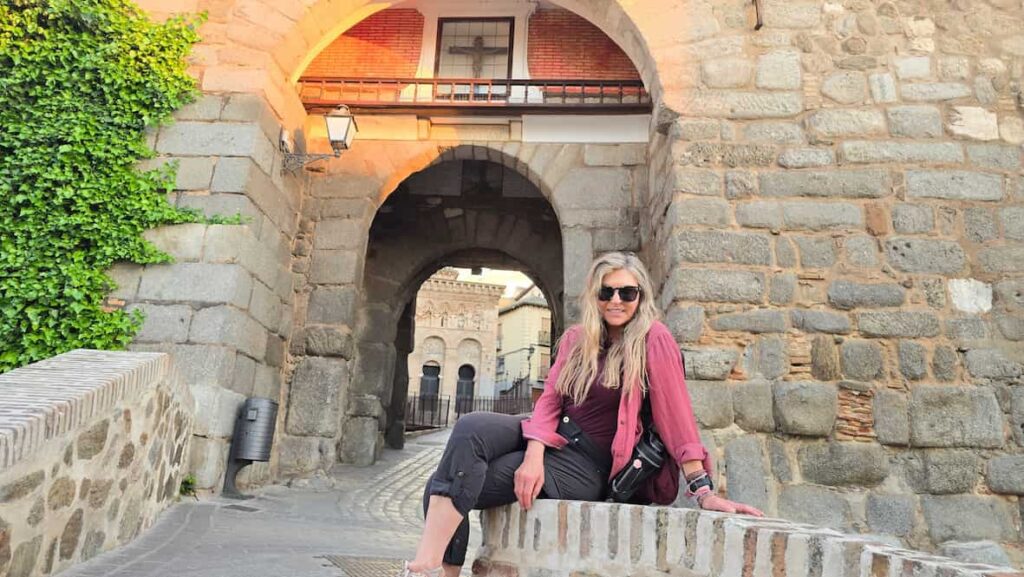
Other notable gates with their remaining ancient walls are Puerta del Sol (Sun Gate) and the Puerta de Alfonso VI (Alfonso VI Gate).
El Greco Museum: The El Greco Museum is dedicated to the artistic works of El Greco during his time in Toledo.
Toledo Walking Streets

Rather than remaining on primary routes like Calle Mayor, navigate the smaller streets within the Judería (Jewish Quarter), especially the vicinity of Plaza de Barrio Nuevo.
This area has hidden courtyards, artisan workshops specializing in Damascene work (metal art work originating in Damascus) or local ceramics, and a more authentic connection to the city’s history.
In addition, walk down Calle Alfileritos (means: little pins) which has a unique tradition: Young women who wanted to find a husband, would come to a wall on this street with the image of the Virgin Mary and push pins into it while they whispered their wish. Try to see some of the spots where pins still remain.
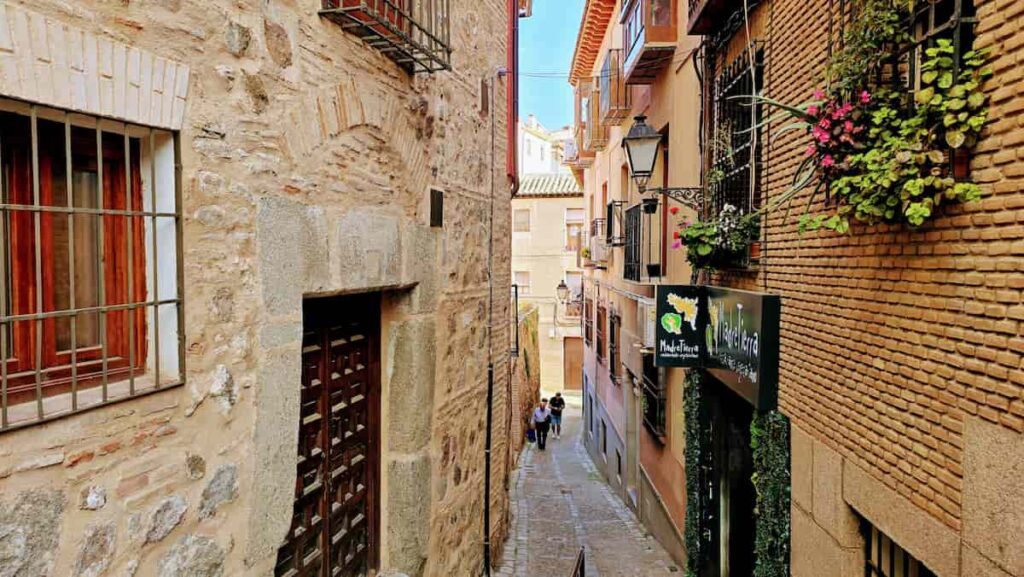
The area surrounding the Toledo Cathedral is a treasure trove of narrow, winding streets to get lost in and explore. Here are some specific ones to explore:
Calle Cardenal Cisneros: While it can be a bit more commercial, it offers impressive views of the Cathedral’s facade as you approach and has a historic feel due to its grand buildings.
Calle del Arco de Palacio: This street offers picturesque views of the Archbishop’s Palace and the Cathedral’s surroundings through its archway.
The unnamed network of alleys behind the Cathedral’s south side: Explore the small lanes that branch off from streets like Calle Trinidad and Calle Sixto Ramón Parro. These reveal hidden corners, small plazas, and beautiful architectural details of the Cathedral’s exterior.
Where to See the Sunset in Toledo

There are a few fantastic places in Toledo to catch the sunset. Here are our favorites:
- Come to the Paseo-Mirador Virgen de Gracia. If you have time, bring some drinks and snacks as there are park benches to sit at (also a children’s playground). These are amazing views of the Monasterio de San Juan de los Reyes and the River Tagus below.
- Walk across the Alcántara Bridge at sunset for the best photo of the old city as you look up at it from below.
- The Mirador del Valle is another great spot to see the sunset with the whole city and the river Tagus in your shot. Keep in mind that this spot is about 2.4 km outside of the city.
Toledo Local Food
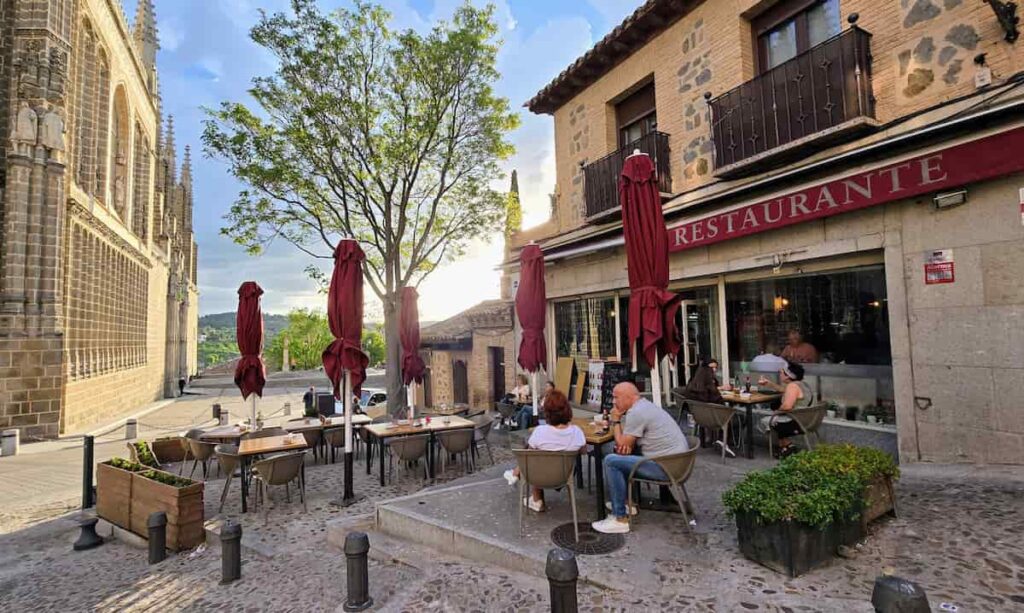
Toledo has a rich culinary scene with distinctive local dishes like the hearty pork stew called carcamusas (typically served as a tapa), flavorful perdiz a la toledana (partridge), and comforting sopa de ajo (garlic soup). For dessert try the famous Toledo marzipan for a sweet treat and the locally produced Queso Manchego. Here are some non touristy restaurants that offer these dishes:
La Cábala Restaurante is a great option in the Jewish Quarter known for their upscale 4 course lunch menu that is fairly priced. They even pair it with wine.
Restaurante El Peñón is known for their traditional Toledan dishes, including paella and grilled meats.
Taberna Skala is an earthy traditional restaurant that has reasonable prices. Try the Carcamusas here.
How to Get to Toledo from Madrid
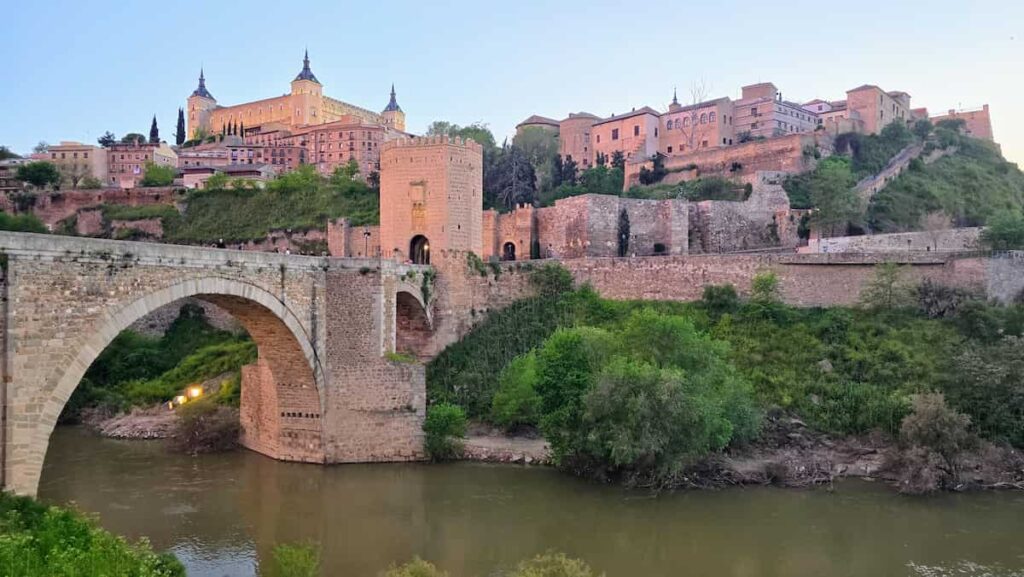
Toledo is located about 70 km (43 miles) south of Madrid and is very well-connected.
Fast Train (AVE/Avant):
Where to take it from: The high-speed trains to Toledo depart from Madrid-Puerta de Atocha-Almudena Grandes train station. This is Madrid’s largest train station and is centrally located, easily accessible by Metro (Atocha Renfe station on Line 1).
How to book it:
Online: You can try to book the tickets online through the official Spanish rail operator, Renfe. However, we had nothing but problems trying to use this site. Therefore, Trainline or Omio are good workarounds. Booking a return ticket is cheaper and it is essential to book in advance especially for weekends and holidays.
At the station: You can also purchase tickets at the Madrid-Puerta de Atocha station from the main office (which is past the garden) or the self-service machines. However, queues can be long, especially during peak hours and weekends.
Keep in mind that tickets do return into the pool as folks cancel. Our last trip to Toledo all the train tickets were booked for days, but we came to the main office at the station and 3 tickets were put back into the system just as we were there – so that is an option as well if you are lucky.
Journey time: The fast train journey is very quick, taking approximately 30-35 minutes.
Frequency: There are frequent departures throughout the day, usually at least hourly.
Bus: Buses to Toledo depart from Madrid’s Plaza Elíptica bus station. This station is accessible by Metro (Plaza Elíptica station on Lines 6 and 11).
The main bus operator is ALSA. You can book tickets online or at the Plaza Elíptica station.
The journey time by bus is around 50 minutes to 1 hour, depending on traffic.
Buses are a slightly cheaper alternative to the fast train.
Segovia
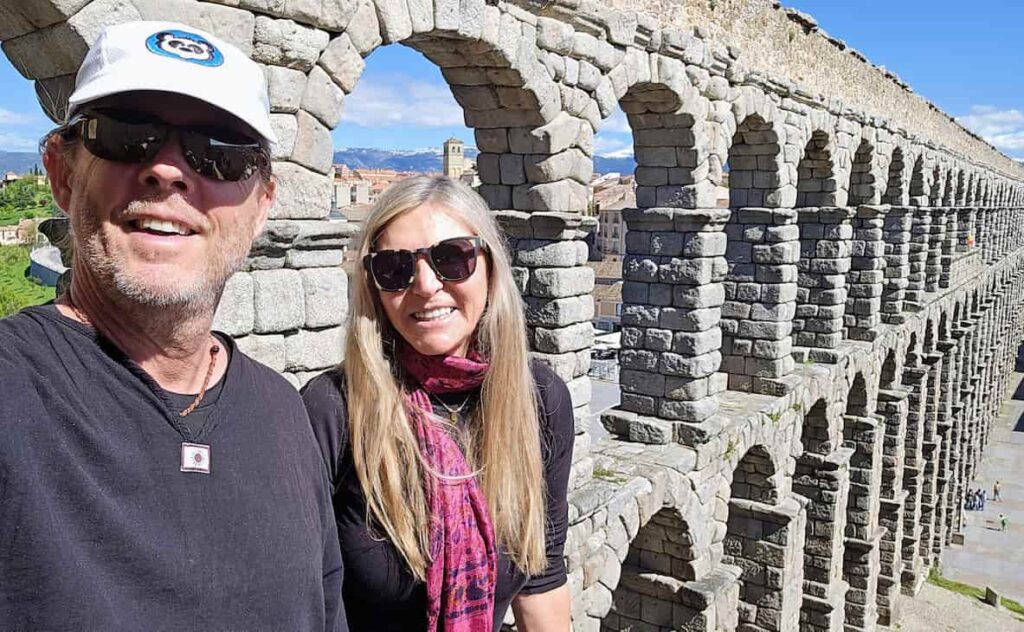
Northwest of Madrid, Segovia, a UNESCO World Heritage site is one of the top towns near Madrid Spain that you must visit! Segovia is celebrated for its remarkably preserved Roman aqueduct and Alcázar castle. It is also one of the walled cities in Spain that can’t be missed.
So in Segovia you will see the amazing Roman engineering, the charm of the Middle Ages, and get to taste the delicious food of the Castile area. In addition, the little alleyways all over this medieval city, especially in the Jewish Quarter are fantastic and make Segovia one of my absolute favorite towns near Madrid Spain.
Two things really stand out in this town. First of all the huge Roman aqueduct that you can’t miss as it towers over the city, and the magical Alcázar castle, which some people think might have even inspired Walt Disney’s castle designs.
Notable attractions
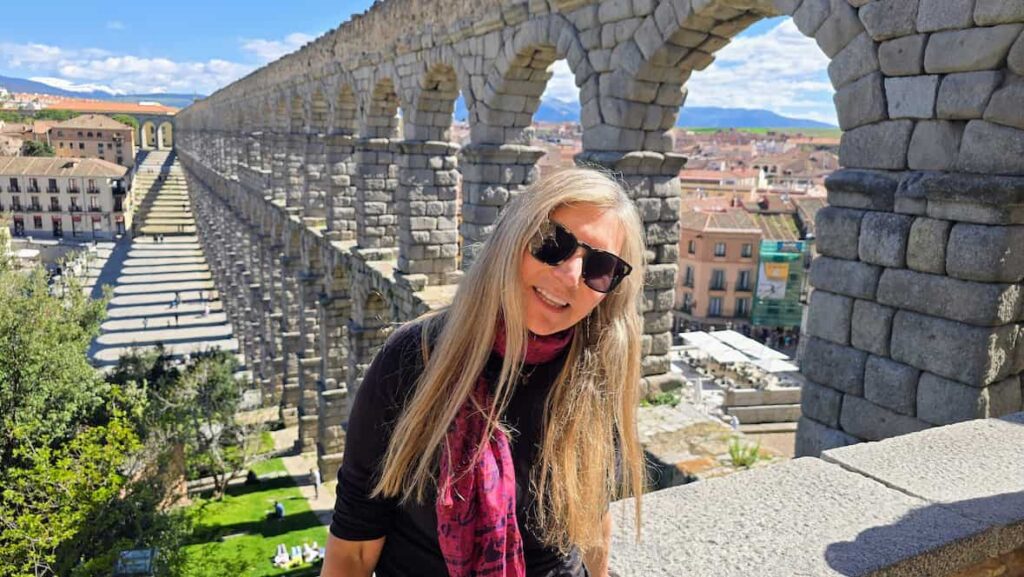
The Roman Aqueduct: A remarkable feat of ancient engineering from the 1st century AD, prominently situated in the city center.
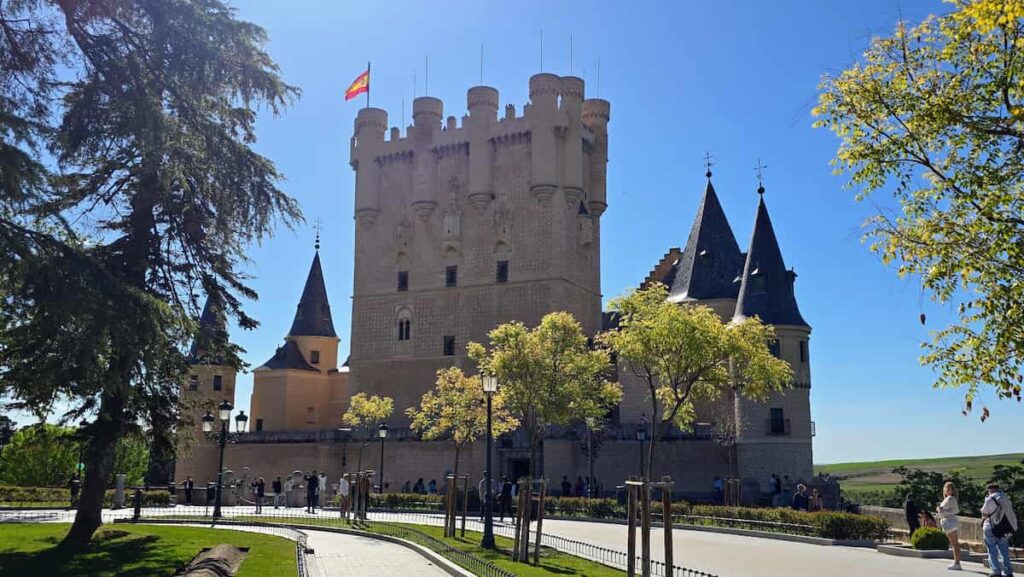
The Alcázar of Segovia: A striking 12th century castle offering extensive views over the verdant valley was once a royal residence and later a military academy. Ascending the tower provides the best panoramic views.
Personally, I didn’t think that entering the castle was really worth it as there wasn’t that much inside to see. However, the views from above are quite striking. Keep in mind, you also get great views from the viewing platforms outside of the castle (where you do not need to pay the entry fee). Price was 7 euros for the castle and an additional 3 euros for accessing the tower.
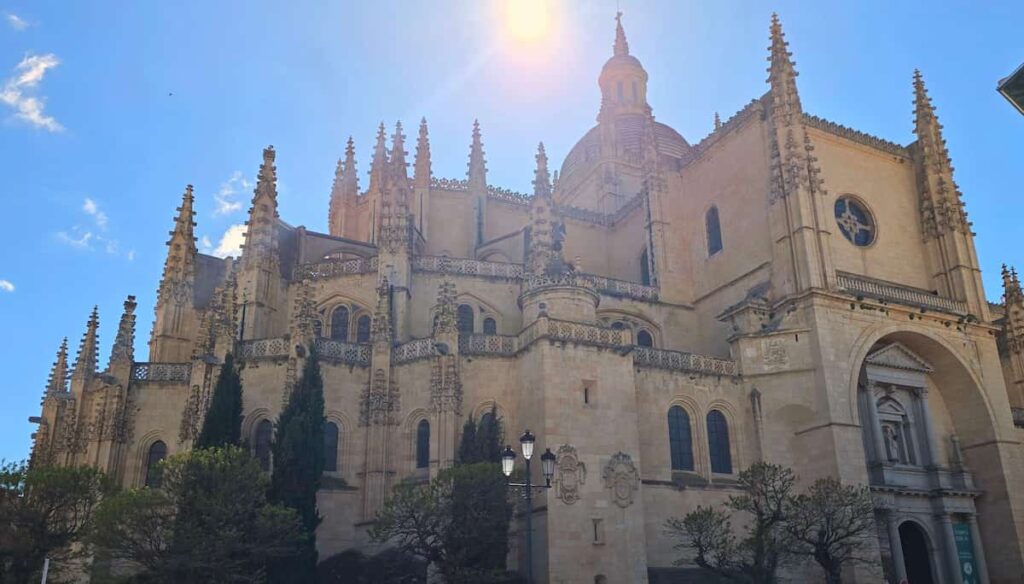
Segovia Cathedral: Last Gothic style cathedral built in Spain (building started in 1525), it is a good example of late Gothic architecture, often referred to as the “Lady of Cathedrals.” Notice the stained glass windows, high vaults and the intricate detailing of its facade.
There is a small museum inside the cathedral along with access to the cloisters. Although we are not religious people, we appreciated the artwork inside and thought that the ticket was worth the entry fee (4 euros).
The Jewish Quarter: Explore the narrow streets and historic buildings that once were Segovia’s Jewish community, particularly around Calle de la Judería Vieja and Calle la Puerta del Sol. The former synagogue now serves as a cultural center.
Plaza Mayor: The central square, located at the end of the street called Calle Real, which is one of the most famous streets in Segovia. Within Plaza Mayor, you can find several important buildings, such as the town hall, the Juan Bravo Theater, the San Miguel Church, and the Cathedral.
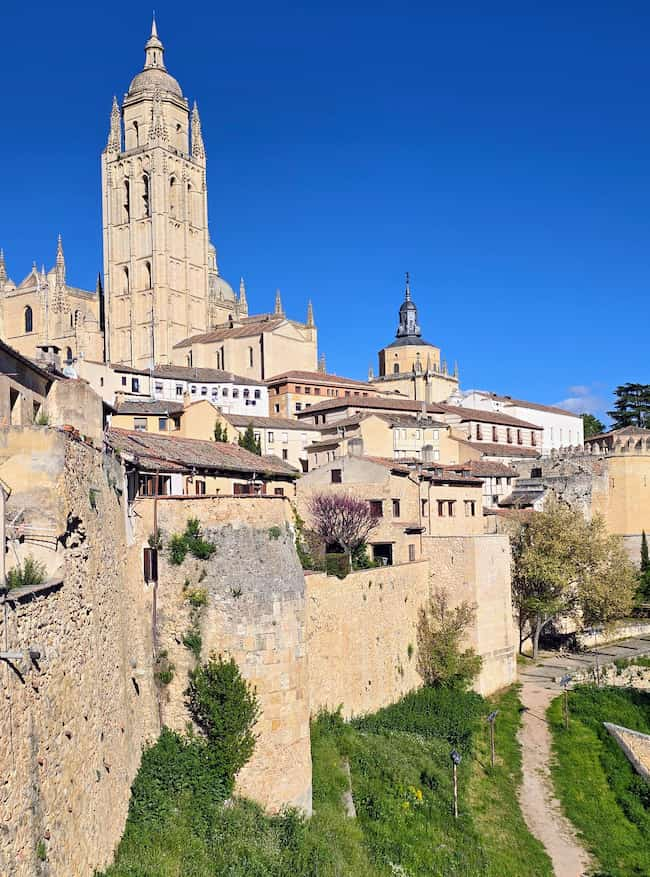
La Muralla de Segovia: This is a short walk right on the remaining pieces of the walkable part of the walled cities in Spain. The ticket can be purchased in the nearby office (beside Puerta de San Andres) for a few euros and you will receive the code for the gate to walk up the stairs and stand on this ancient piece of history with views to the castle and the valley below.
There is also a path below the wall that runs along it. To access the path follow the street to your left as you face away from the Alcázar, through Puerta de Santiago, then follow the path next to the bridge. This gorgeous path is surrounded by history and nature.
Segovia Walking Streets
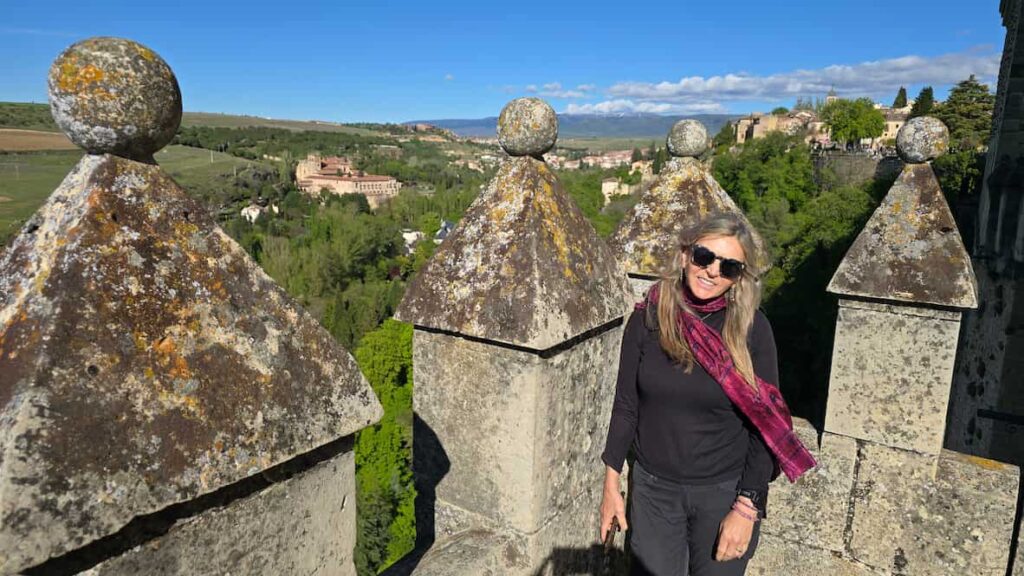
One can spend hours weaving in and out of Segovia’s charming little streets and alleyways. However, since you are most likely here on a day trip, we are providing the most interesting, picturesque and relevant ones to stroll:
Calle Juan Bravo (also known as Calle Real): This artery connecting the Aqueduct to Plaza Mayor is a gently sloping street lined with shops and inviting restaurants.
Streets of the Jewish Quarter (La Judería): Wander these serene, narrow cobblestone lanes to absorb centuries of history. Once the heart of Segovia’s Jewish community until 1492, the intimate alleyways tell tales of a rich cultural past.
Don’t miss the Puerta de San Andrés, or the Puerta del Sol – remarkably preserved medieval gates within the quarter. As you walk through the Puerta del Sol on Calle la Puerta del Sol you will find a broad greenbelt park called Paseo del Salon which is just lovely.
Calle Cervantes: Your initial path from the Aqueduct towards the old city has the first glimpses into Segovia’s historic charm and leads you towards the Mirador de la Canaleja for early panoramic views.
Calle Del Grabador Espinosa has delightful covered walkways that connect buildings across it’s narrow street.
Calle de la Infanta Isabel has narrow walkways and little cafes that are so charming!
Segovia Local Food

Avoid the immediate vicinity of the aqueduct on Plaza del Azoguejo and venture further. Restaurants (casas de comidas) on streets such as Calle Cronista Lecea, including the long-established Restaurante José María, are known for serving authentic cochinillo asado (suckling pig) and judiones de la granja (farm bean stew from the region). Here are a few other places:
El Sitio is a traditional castilian restaurant serving the most famous food of the region including: cochinillo and judiones de la granja. It is set in a cozy dining space that has wood-beamed ceilings.
Casa Comala is a fusion restaurant of Mexican and local cuisines creating very interesting dishes loved by the locals in Segovia. Try the yuca fries and the Cochinita Pibil.
After your lunch try the ponche segoviano, a traditional almond and custard confection served best at Panadería Pastelería Molinga which is a bit out of the way but worth it.
How to Get to Segovia from Madrid
Segovia is roughly 90 km (56 miles) northwest of Madrid and is easily accessible on a day trip from Madrid.
Fast Train (Avant):
Where to take it from: High-speed Avant trains to Segovia-Guiomar station depart from Madrid-Chamartín-Clara Campoamor train station. This major station in northern Madrid is easily accessible via Metro (Chamartín station on Lines 1, 10, and the suburban Cercanías lines). However, the Guiomar train station in Segovia is a ways from the old town. Here are 3 ways to get into the old town:
- Take a bus from Estacion AVE to the Centro on: Line 11 or 12.Cost was: 2.25 Euros
- Take a taxi from Segovia Guiomar to the Centro 7.1 km which will take 10 min. Cost was €10
- Or you can walk from Segovia Guiomar to Segovia Centro 5.7 km which will take approximately 1h 8m depending on your pace.
How to book it:
Online: We had a hard time booking through Renfe and therefore highly recommend the Omio website which has more options – although it is a bit more expensive.
At the station: Tickets can be bought at Madrid-Chamartín station from ticket windows or self-service kiosks. Be prepared for potential queues, especially during busy periods.
Journey time: The high-speed train typically takes around 30 minutes. However, remember that there is that additional taxi or bus ride once you get to the Guiomar train station in Segovia.
Frequency: Departures are frequent throughout the day, generally with at least hourly service.
Bus:
Where to take it from: Buses to Segovia primarily depart from Madrid’s Moncloa bus station. This station is well-connected via Metro (Moncloa station on Lines 3 and 6).
How to book it: The primary bus operator is AvanzaBus. You can book tickets online or at the Moncloa station.
Journey time: The bus journey takes approximately 1 hour to 1 hour and 30 minutes, depending on the specific route and traffic conditions. The good news is that this bus will drop you off right at the Segovia and you will not need to take additional transport.
Ávila– One of the Most Preserved of the Walled Cities in Spain
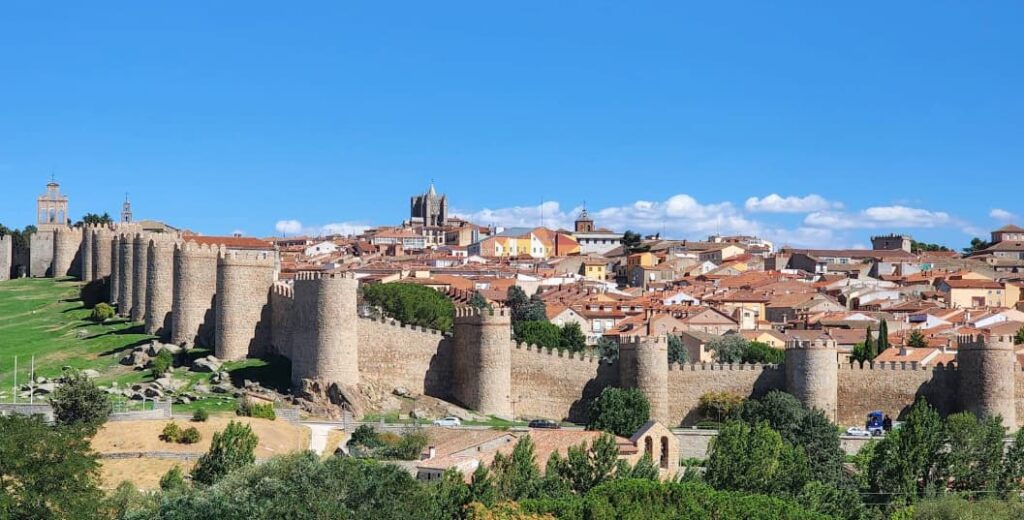
West of Madrid is Ávila, a UNESCO World Heritage site and one of the most well-preserved walled cities in Spain. It is one of the top 3 towns near Madrid Spain that are unmissable. Ávila is known for its remarkably complete medieval city walls and its spiritual heritage, tied to Saint Teresa of Ávila.
For me, Avila was one of the walled cities in Spain that transported me back in time. In addition, the food is quite spectacular and filled with hearty flavors of the Castile and León regions.
Notable attractions:

The Walls of Ávila: These magnificent 11th-century walls are one of the best-preserved medieval fortifications in Europe, stretching over 2.5 kilometers and featuring numerous towers and gates. Walking along the ramparts offers unparalleled views of the city and the surrounding landscape.
Ávila Cathedral: A unique fortress-like cathedral, seamlessly integrated into the city walls. Construction began in the 12th century, showcasing a blend of Romanesque and Gothic styles. Its austere beauty reflects the city’s defensive nature.
Monastery of Saint Teresa (Convento de Santa Teresa): Built on the site of Saint Teresa’s birthplace, this important religious site features a Baroque church and a museum dedicated to the life and works of this influential mystic.
Church of San Vicente: A stunning example of Romanesque architecture in Ávila, known for its intricate sculptural details on the western facade and the impressive tomb of the saint.
Plaza Mayor: The lively central square of Ávila, a perfect place to soak in the atmosphere, enjoy a coffee, and admire the surrounding historic buildings, including the City Hall.
Ávila Walking Streets
Exploring Ávila’s old town on foot is the best way to appreciate its medieval charm and see the nooks and crannies of the place. Here are some key streets and areas for a memorable stroll:
The Walls (Paseo de la Muralla): Walking along the top of the ancient walls offers lovely panoramic views of the city and the surrounding countryside. Access points are located at various gates and visitors can walk about 1700 meters of the walls.
Streets within the Walls: Lose yourself in the maze of narrow cobblestone streets within the walled city. Every turn reveals charming corners, ancient houses, and small churches, each with its own story. Pay particular attention to the areas around the Cathedral and the Church of San Vicente. Here are some of our favorite areas and streets:
Plaza del Mercado Chico (Plaza Mayor): This is the heart of Avila, a picturesque square surrounded by historic buildings, most notably: the Ayuntamiento de Avila (City Hall) and the church of San Juan Bautista where Santa Teresa was baptised.
Catch a gorgeous sunset at the Cuatro Postes Lookout – one of the top viewpoints of Avila where you can see the sun go down over the walled town.
PRO TIP: Consider renting a bicycle in Avila to circumnavigate the full wall. You can get a bike at Avila Beach Bike Rentals which is Located at 51 San Miguel Street.
Ávila Local Food
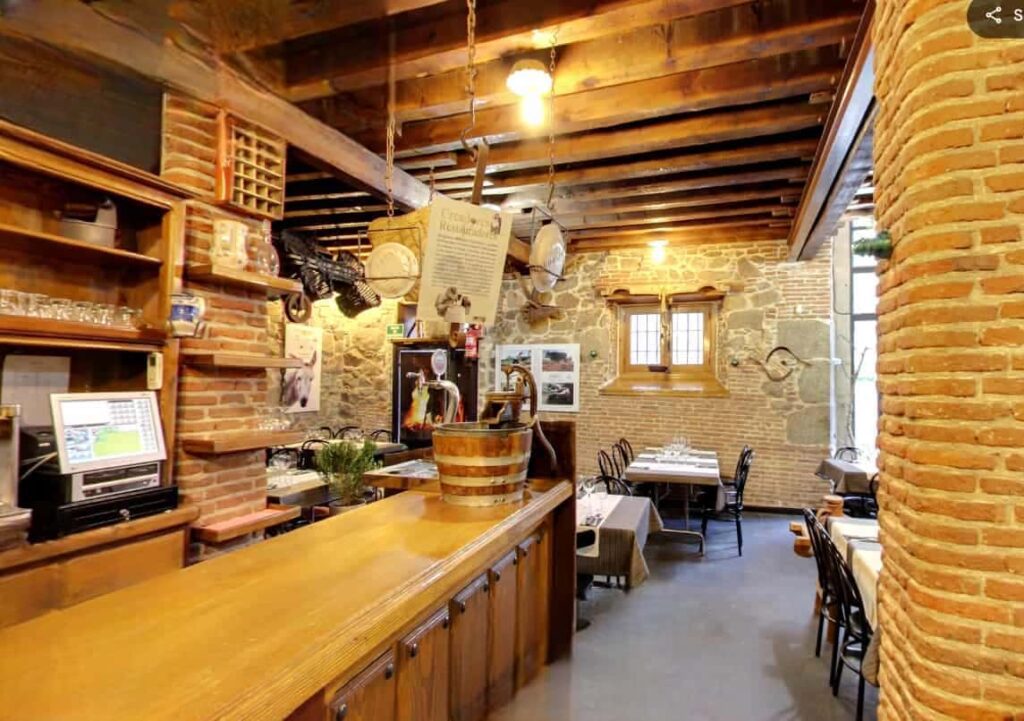
Venture away from the immediate vicinity of the main gates to discover good local eateries. Some of the foods of the region are chuletón de Ávila (a thick-cut, grilled beef steak) and patatas revolconas (mashed potatoes with paprika and bacon). Here are a few recommendations for restaurants in Avila.
Restaurante Siglo Doce: Situated within the walls, this restaurant offers traditional Castilian cuisine, including the famed chuletón, in a 12th-century building with exposed brick & wooden beams.
Las Recetas de Isa: Known for their tortilla espanola and other hearty dishes at good prices with lovely service.
Cervecería La Cigueña: A popular spot with locals,, this brewery is located near the Renfe station. It is a small but cozy place, with three tables surrounded by bench seats and a small bar offering 11 beers on tap and tapas.
Don’t leave Avila without trying yemas de Santa Teresa, sweet egg yolk confections that are a local delicacy. You’ll find them in many pastry shops throughout the city.
How to Get to Ávila from Madrid
Ávila is located approximately 115 km (71 miles) northwest of Madrid and is well-connected for a convenient day trip.
Train
Where to take it from: Regional trains to Ávila depart from Madrid-Príncipe Pío train station. This station is easily accessible by Metro (Príncipe Pío station on Lines 6 and 10) and Cercanías (local commuter train).
How to book it:
Online: Tickets can be purchased through the official Spanish rail operator, Renfe or Omio.
At the station: Tickets are also available at Madrid-Príncipe Pío station from ticket windows and self-service machines.
Journey time: The train journey typically takes around 1 hour and 30 minutes to 2 hours, depending on the specific train.
Frequency: There are several departures throughout the day.
Bus
Where to take it from: Buses to Ávila primarily depart from Madrid’s Estación Sur (Méndez Álvaro) bus station. This major bus terminal is accessible via Metro (Méndez Álvaro station on Line 6).
How to book it: The main bus operator is AvanzaBus. You can book tickets online or at the Estación Sur.
Journey time: The bus journey takes approximately 1 hour and 30 minutes to 1 hour and 45 minutes, depending on traffic.
Cost: Buses are generally a slightly more economical option compared to the train.
Car
Route: Ávila is easily reached by car via the A-6 highway northwest from Madrid, followed by the AP-51 toll road or the N-110.
Journey time: The drive takes approximately 1 hour and 15 minutes to 1 hour and 30 minutes, depending on traffic and the chosen route.
Parking: Parking is available outside the city walls. Several paid parking lots are located near the main gates, providing convenient access to the historic center. Parking within the walls is generally restricted.
Top Tips – Visiting Towns Near Madrid Spain
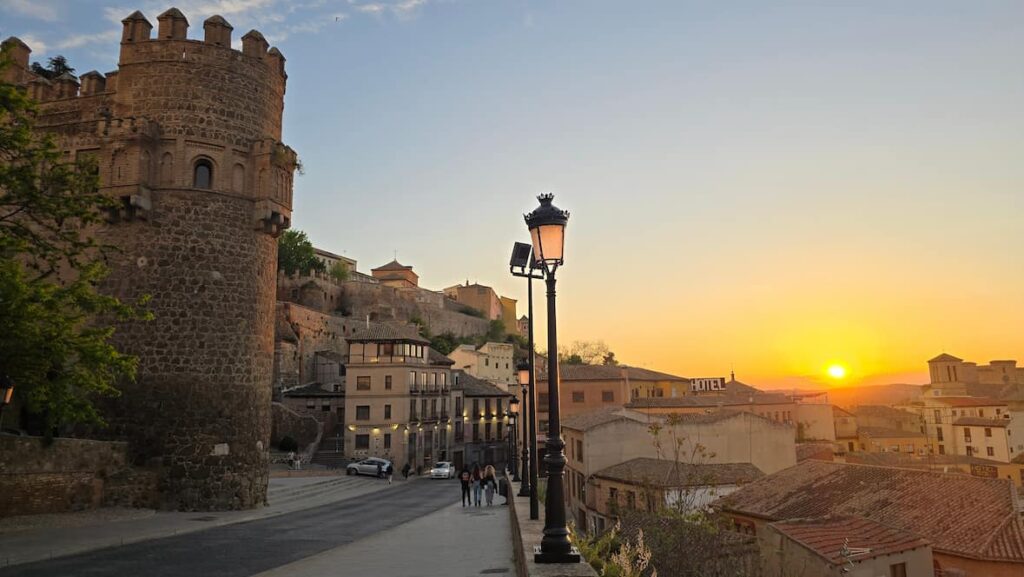
🚆 Buy Renfe Cercanías tickets online — sometimes machines are broken at small stations (Reddit tip).
🚗 Avoid renting a car for Segovia or Toledo unless you stay overnight — city centers have limited parking.
🧳 Pack a small day bag only — cobblestones and hills make rolling luggage painful.
What to bring – If you are visiting with limited time you may not have time to sit down in a restaurant and oddly the supermarkets in Toledo and Avila were very limited in the old town (plentiful in Segovia).
Therefore bring some snacks and a water bottle as there are fountains throughout all 3 cities near Madrid. Because of elevation it does get chilly in the evening, so a sweater or windbreaker is recommended. And don’t forget the sunscreen as the sun is plentiful in the day!
🕐 Visit midweek — Tuesdays to Thursdays are ideal to avoid crowds. Avoid Monday trips: Many museums and small-town attractions close on Mondays.
⭐ Avoid Semana Santa (Holy Week) for Toledo, Ávila, and Segovia unless you want to experience heavy religious festivals — stunning, but extremely crowded and expensive for hotels.
Wrap Up – 3 Magical Towns Near Madrid Spain
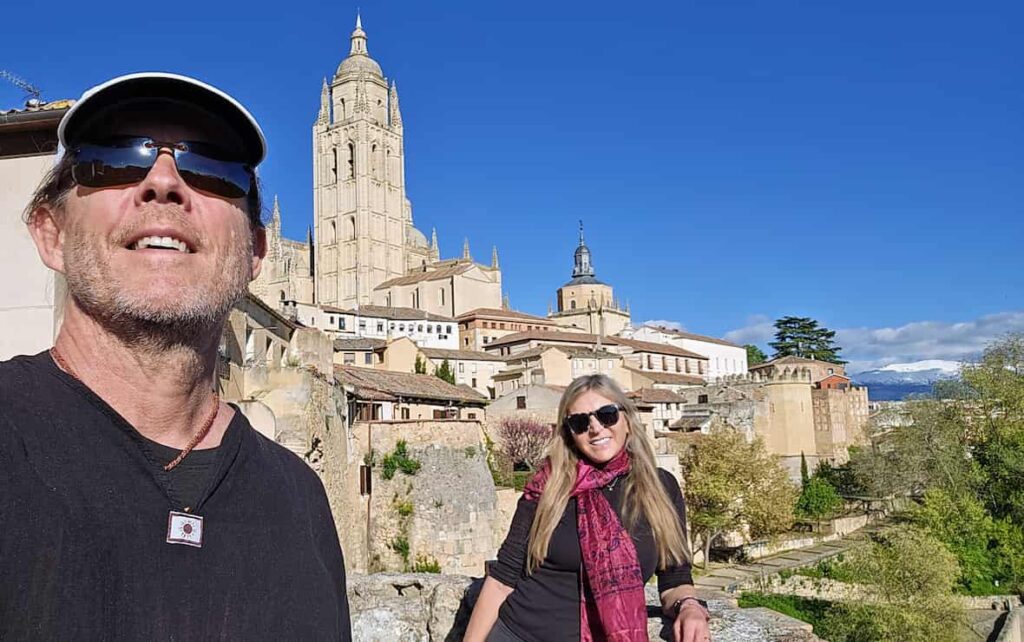
Whether you’re wandering along ancient walled cities in Spain, enjoying a glass of wine in a quiet plaza, or discovering hidden medieval castles, each stop offers something unique. Plan a few of these cities near Madrid into your itinerary — you’ll be rewarded with experiences most tourists miss!
Of all the towns near Madrid Spain, Segovia was our favorite due to it’s incredible Aqueduct, medieval charm and maze of tiny alleyways, cobblestone streets (especially in the Jewish Quarter) and paths running along it’s walls.
In Toledo, the views from the many viewpoints (miradores) of the Jewish Quarter are gorgeous. Just walking up to this medieval town from the train station provides so many stunning views taking you back in time. Toledo is one of the cities near Madrid that is the easiest to get to from central Madrid – so even if you have half a day, you will be rushed but go for it!
And then there is Avila – the best (in our opinion) of the walled cities in Spain as you can still walk so much of it’s ramparts. This is one of the cities near Madrid that does take a bit longer to get to. However when the walls get lit up at night and transport you back in time, we hope you will find the journey worth your time as much as we did.
Have you been to any of the towns or cities near Madrid? What were your favorite ones? Please let us know in the comments. And if you are planning a trip here, and have questions please do drop a line in the comments and we will try to provide as much additional information as we can to make your Madrid Spain itinerary magical.
Also, have you been to the gorgeous coast of Spain? We found some gorgeous beaches in Alicante in Costa Blanca that we can highly recommend.

